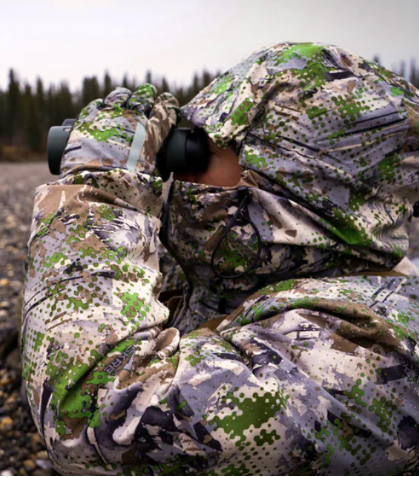Conseils d'entretien pour les vêtements de chasse imperméables: prolongez la durée de vie de votre équipement
May 16, 2025
En investissant dans des vêtements de chasse imperméables de haute qualité, vous n'achetez pas seulement du confort : vous achetez aussi performance et protection lorsque la météo se dégrade. Qu'il s'agisse d'une averse soudaine lors d'une chasse à l'élan en pleine nature ou de longues heures passées à observer sous la neige fondue, votre équipement imperméable est votre bouclier. Mais pour préserver cette protection saison après saison, un entretien régulier est essentiel.
Dans ce guide, nous expliquerons exactement comment prendre soin de votre équipement de chasse imperméable afin qu'il continue de vous garder au sec, silencieux et concentré sur le terrain.
Découvrez nos vêtements de chasse imperméables
SKRE Gear® propose des vêtements de chasse imperméables haut de gamme, parfaits pour la chasse par temps humide et froid. Achetez dès maintenant.
Achetez des vêtements de pluie
Pourquoi un entretien approprié est important
Même les vêtements de pluie les plus performants ne dureront pas éternellement s'ils sont négligés. Avec le temps, la saleté, la transpiration, les huiles corporelles et les saletés du camping peuvent obstruer les pores du tissu et dégrader les membranes imperméables. Ajoutez à cela un lavage ou un rangement inapproprié, et vous vous retrouvez avec des vêtements qui risquent de s'infiltrer ou de se défaire au moment où vous en avez le plus besoin.
Voici ce qu’un entretien approprié vous aide à faire :
- Préserver les performances imperméables et respirantes
- Prévenir l'usure
- Élimine l'accumulation d'odeurs
- Prolonger la durée de vie des vêtements coûteux
- Assurer un confort constant pendant les chasses
Soins essentiels après la chasse

Nettoyage des équipements imperméables
Vous n'avez pas besoin de laver votre équipement de pluie après chaque chasse, mais une fois qu'il a été fortement utilisé, exposé à la boue ou au sang, ou qu'il commence à être collant ou moite, il est temps de le nettoyer correctement.
Faire:
- Utilisez un lavage technique comme Nikwax Tech Wash ou Granger's Performance Wash.
- Choisissez de l’eau froide et un cycle de lavage doux ou à la main.
- Rincez abondamment pour éliminer tout le savon et les résidus.
- Essuyez les fermetures à glissière, les coutures et les bandes Velcro pour éviter toute accumulation.
Ne le faites pas:
- Utilisez des détergents à lessive standard, de l’eau de Javel ou des assouplissants : ils peuvent éliminer l’imperméabilité et laisser des résidus qui attirent l’eau.
- Laver avec d’autres équipements qui peuvent contenir de la saleté ou des huiles.
Conseil de pro : Fermez toutes les fermetures à glissière et attachez les poignets ou les sangles avant le lavage pour éviter les accrocs.
Sécher correctement
Après le lavage, le séchage est tout aussi important. La plupart des vêtements imperméables peuvent être séchés en machine à basse température, ce qui peut réactiver le revêtement DWR (nous y reviendrons plus tard). Vérifiez toujours l'étiquette au préalable.
En cas de séchage à l'air libre :
- Accrochez votre équipement dans un endroit bien aéré, à l’abri de la lumière directe du soleil.
- Utilisez un séchoir pour les pantalons et les bavoirs afin de garantir que l’air circule à l’intérieur.
Éviter:
- Chaleur élevée (qui peut endommager les membranes)
- Séchage au feu de camp ou chauffages, qui peuvent faire fondre ou affaiblir les couches extérieures
Comment restaurer la déperlance
Votre coque extérieure n'est pas seulement imperméable grâce à la membrane intérieure : elle est également recouverte de DWR (Déperlant durable) qui fait perler l'eau et la fait glisser sur le tissu. Avec le temps, ce revêtement s'use sous l'effet de l'abrasion, de la saleté et des lavages.
Signes que votre DWR est en panne:
- Le tissu semble lourd ou saturé lorsqu'il est mouillé
- L'eau pénètre dans la surface au lieu de perler
- Vous avez froid ou vous sentez moite même lorsque la veste est techniquement « imperméable ».
Comment réappliquer le DWR :
- Lavez soigneusement votre équipement.
- Pendant qu'il est encore humide, appliquez un traitement DWR par pulvérisation ou lavage.
- Sécher en machine à basse température pour fixer le traitement (si l'étiquette le permet).
Options populaires :
- Nikwax TX.Direct
- Granger's Performance Repel
- Gear Aid Revivex
Répéter toutes les 1 à 2 saisons ou selon les besoins en fonction de l’utilisation.
Conseils de stockage pour éviter les dommages
Une fois la saison terminée, ne vous contentez pas de jeter vos vêtements de pluie dans une poubelle. Un mauvais rangement est l'un des moyens les plus rapides d'abîmer des vêtements d'extérieur coûteux.
Bonnes pratiques :
- Rangez toujours votre équipement propre et sec : même une légère humidité peut entraîner la formation de moisissures.
- Accrochez les vestes et les pantalons dans un placard frais et sec.
- Évitez la compression ou le pliage pendant de longues périodes, car cela peut endommager les membranes.
- Conservez-les dans des sacs respirants (comme des housses à vêtements en filet) – évitez les contenants hermétiques ou les bacs en plastique.
Conseil de pro : Si l’humidité est un problème, placez un pack de gel de silice ou un absorbeur d’humidité dans votre placard à équipement.
Soins sur le terrain et prévention des dommages
Prendre soin de son équipement ne s'arrête pas à la buanderie. Un peu de vigilance sur le terrain

peut contribuer grandement à prévenir les dommages.
Faire:
- Secouez l'eau et la boue avant de ranger votre équipement
- Roulez, ne mettez pas votre veste dans un sac
- Emportez des kits de réparation pour les petites déchirures ou abrasions
- Évitez de vous frayer un chemin dans les buissons ou de ramper sur les rochers, sauf si nécessaire.
Éviter:
- Se tenir trop près des feux de camp (les braises peuvent faire fondre votre équipement)
- S'asseoir directement sur des bûches brutes ou de la pierre - utiliser un coussin de siège
- Laisser les fermetures à glissière traîner dans la saleté ou geler avec l'humidité
Découvrez nos vêtements de chasse imperméables
SKRE Gear® propose des vêtements de chasse imperméables haut de gamme, parfaits pour la chasse par temps humide et froid. Achetez dès maintenant.
Achetez des vêtements de pluie
Quand remplacer ou mettre au rebut un équipement
Même le matériel le mieux entretenu finit par s'user. Voici comment savoir quand le réparer ou le remplacer :
- Membranes décollées ou délaminées qui ne peuvent pas être réparées
- Fuites persistantes même après un retraitement DWR et des contrôles des coutures
- Fermetures éclair cassées, poignets effilochés ou tissu si fin qu'il est presque translucide
Si les réparations coûtent plus de 50 % du prix de remplacement, ou si l'équipement n'est plus performant sur le terrain, il est temps de le mettre à niveau.
Conclusion
Bien entretenir vos vêtements de chasse imperméables n'est pas compliqué, mais crucial. En prenant quelques précautions avant et après vos chasses, vous préserverez la performance, le confort et la valeur de votre équipement pour les années à venir.
Souviens-toi:
- Utilisez les bons nettoyants
- Réappliquez le DWR si nécessaire
- Rangez correctement votre équipement
- Manipulez-le avec précaution sur le terrain
Besoin d'un équipement conçu pour durer ? Découvrez les équipements SKRE conçus pour des conditions extrêmes et conçus pour résister à la chasse, saison après saison.



